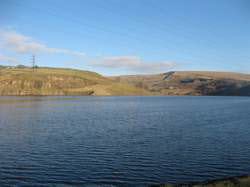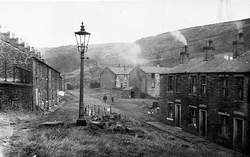Abandoned Communities ..... Rochdale Reservoirs
Submerged under the Greenbooth reservoir are the remains of a weaving mill and the village of Greenbooth. The reservoir lies three miles north west of Rochdale, just outside the village of Norden. The weaving mill was built in the 1840s on or near the site of a corn mill. It specialised in producing woollen flannel, which would have been distributed to clothing manufacturers across northern England. Its original owner was James Butterworth, who in due course passed it to his son-on-law, a Mr Hutchinson.
Coal was supplied to the mill from the East Knowl colliery. It was transported from the colliery by means of an overhead cable.
James Butterworth created a small village close to his mill to provide accommodation for the staff. There were two rows of terraced housing immediately next to the mill, and larger houses for managers on Cameron Street and part of Greenbooth Road. Rents were deducted from wages, and other deductions were made to pay for such items as milk deliveries. A shop and a school were provided, but there was no church or public house in the village. The village had a gas supply, but apparently never received electricity.
The mill closed in 1911. The reason for its closure is unclear, but it may have been because the owner decided to emigrate with some of the staff to Australia, where he established a new factory.
Greenbooth village continued to exist after the closure of the mill. The school closed in 1930, and thereafter children had to walk into Norden to go to school.
The memories of several former residents and others with a close personal connection with Greenbooth have been recorded. They can be found in several articles at the Touchstones Local Studies Centre in Rochdale; in the Greenbooth Memories website created by Adam Lees; and in Henry Buckton's book The Lost Villages: In Search of Britain's Vanished Communities, published by I B Tauris in 2008.
Some of the recorded reminiscences date back to the time before the closure of the mill. In particular memories of Mrs Hutchinson, the wife of the mill owner, often crop up. Mrs Hutchinson took it upon herself to maintain regular inspections of the school and each house in the village. She travelled around the village in a horse drawn carriage. It was said that even a dirty door step would bring a sharp reprimand from her.
Monday was washing day, at least while the mill was still open. A large vat at the entrance to the mill was filled with hot water, and housewives would take buckets and fill them with a long handled scoop. Another place fondly remembered by people who had been children in the village was the sweet shop. It formed part of the front room of one of the houses in Cameron Street. A large flat stone had been placed in front of the window to enable smaller children to see what was on offer. Gob stoppers, sugar mice, aniseed balls, and liquorice shoe laces were especially popular.
The Greenbooth reservoir was built by the Heywood and Middleton Water Board. In the Naden valley north of Greenbooth a string of three smaller reservoirs already existed, and the Greenbooth reservoir was meant to complete the series. Its planning began in 1952, statutory powers to construct the reservoir were obtained from parliament in 1956, and the reservoir was completed in 1963.
Go to the Rochdale Observer 8 June 1963 for a detailed article on the construction of the reservoir.
At the time when Greenbooth village had to be demolished it contained 46 houses. However, there had already been a gradual trend towards moving out of the village as 20 of the houses were derelict. Most of the people living in Greenbooth when the reservoir was built found new homes in Norden or Rochdale.
Coal was supplied to the mill from the East Knowl colliery. It was transported from the colliery by means of an overhead cable.
James Butterworth created a small village close to his mill to provide accommodation for the staff. There were two rows of terraced housing immediately next to the mill, and larger houses for managers on Cameron Street and part of Greenbooth Road. Rents were deducted from wages, and other deductions were made to pay for such items as milk deliveries. A shop and a school were provided, but there was no church or public house in the village. The village had a gas supply, but apparently never received electricity.
The mill closed in 1911. The reason for its closure is unclear, but it may have been because the owner decided to emigrate with some of the staff to Australia, where he established a new factory.
Greenbooth village continued to exist after the closure of the mill. The school closed in 1930, and thereafter children had to walk into Norden to go to school.
The memories of several former residents and others with a close personal connection with Greenbooth have been recorded. They can be found in several articles at the Touchstones Local Studies Centre in Rochdale; in the Greenbooth Memories website created by Adam Lees; and in Henry Buckton's book The Lost Villages: In Search of Britain's Vanished Communities, published by I B Tauris in 2008.
Some of the recorded reminiscences date back to the time before the closure of the mill. In particular memories of Mrs Hutchinson, the wife of the mill owner, often crop up. Mrs Hutchinson took it upon herself to maintain regular inspections of the school and each house in the village. She travelled around the village in a horse drawn carriage. It was said that even a dirty door step would bring a sharp reprimand from her.
Monday was washing day, at least while the mill was still open. A large vat at the entrance to the mill was filled with hot water, and housewives would take buckets and fill them with a long handled scoop. Another place fondly remembered by people who had been children in the village was the sweet shop. It formed part of the front room of one of the houses in Cameron Street. A large flat stone had been placed in front of the window to enable smaller children to see what was on offer. Gob stoppers, sugar mice, aniseed balls, and liquorice shoe laces were especially popular.
The Greenbooth reservoir was built by the Heywood and Middleton Water Board. In the Naden valley north of Greenbooth a string of three smaller reservoirs already existed, and the Greenbooth reservoir was meant to complete the series. Its planning began in 1952, statutory powers to construct the reservoir were obtained from parliament in 1956, and the reservoir was completed in 1963.
Go to the Rochdale Observer 8 June 1963 for a detailed article on the construction of the reservoir.
At the time when Greenbooth village had to be demolished it contained 46 houses. However, there had already been a gradual trend towards moving out of the village as 20 of the houses were derelict. Most of the people living in Greenbooth when the reservoir was built found new homes in Norden or Rochdale.
Five
Greenbooth village and mill
Part of the village in 1955.
These two photographs come from the Gallery page of Adam Lees’ Greenbooth Memories website, where several other pictures of the village and groups of people can be found.
Greenbooth reservoir in January 2011. The seagulls mark the position of the village.


